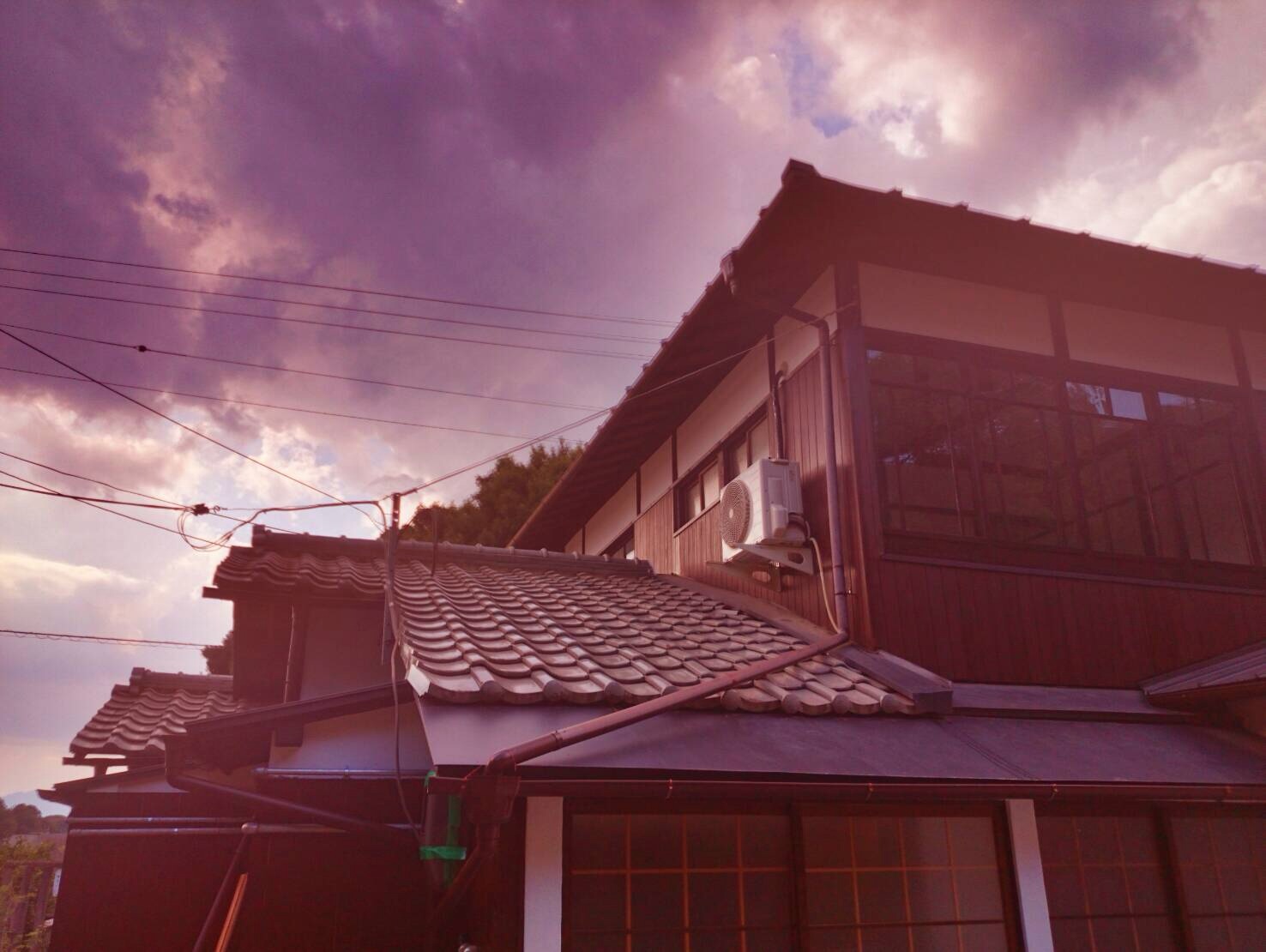築約80年以上の日本家屋に移り住むことに決めました。
場所は京都、鹿ヶ谷。
大文字山の麓にある銀閣寺に近いこの場所で、しばらくの間住まい手がおらず、
やや年月を感じさせるこの長屋を修繕し、居を構えようではないかと計画に着手してから丸一年。
ようやく計画がまとまり、先だって工事が開始されました。
今回この長屋木造二階建ての住居を、自身の住居/Officeの用途以外にも展開させようというもので、
建物を所有する側、迎え入れる側、創る側、住む側、使う側、訪れる側等、、
この家に関わるさまざまな立場からの検討を行う必要があった為、実際の工事開始迄に少々時間がかかった感がありますが、、
− 計画に丸一年 –
実に贅沢な響きではないですか。
正直に申します。私自身、今迄物心ついてからというもの、
ほぼ戸建てどころか木造の家に住むという体験自体が初めてのことです。
しかし建築を生業とする身としまして、築80年以上にわたって成熟してきた日本家屋に純粋に“住まう”ことが出来ることに、
– 色々な国の様々な住まいを見て来た中で – ようやくこの位置に辿り着いたとの思いがあるのです。
常々人の住まうことや、人々に対する建物の在り方について考える身である中で、
当たり前にその地域において採れる•加工される材で、技能を極めた職人によって創られ、
それぞれ時代の要求に応じた変容を通じて、また次の時代に住み継がれていく。。。
つまり一代限りで消費させる ‘持ち家’ という考え方ではなく、
あくまで次の住まい手に引き継ぐまでその価値を保持•向上させる役割を担うという考え方。
これが人と住まいにとって一つの理想の在り方ではないかと思います。
一般的に新築で建てられる家と比べて不便、暗い、耐震性に不安等などの思いが先行し、
“住まい(戸建)とは、すなわち=新築” という図式がまだまだ根強い中、
逆に最近ではこのような年期の入った家屋に魅力を感じる人が増えつつあるように思います。
古家(民家や長屋)を改装したカフェやレストランが身近に増えたことも一つの要因でしょう。
そこで感じる現代の住まいには無い何か深淵なる空間性に加え、
十分に“新しさ”を許容出来る懐の深さのようなものが、より内面に訴える要素ではないでしょうか。
そして願わくば、住まいとして − 現代の感覚でもってより生活を引き立てる器 − の魅力がもっと認知され、
更に評価されればと思うのです。
− しかしそれは決して万人に対して、という意味ではなくて。
瓦の屋根、木の柱に梁が組まれ、石の基礎に漆喰や土の壁など、そして床板に畳敷き、建具は板戸に障子など。
主にこれらの材料で建てられた家は、あくまで経済合理性に重きを置いた現代の住まいの多くとは対極をなすものであり、
住めば当然夏は暑く冬は寒いでしょうし、多少なりとも不便と感じることもあるかもしれません。
(少なくともつい数十年前まではこれらが殆ど万人にとっての住まいだったのですが。。)
しかし、ややもすれば使い古されたとされるこれらの古家を今の時代において、
丁寧に改修しセンス良く住みこなしている人は、自身の生き方に確固たるスタイルを持っている人が多いように思うのです。
そこには盲目的に物質的な豊かさを追い求めるのではなく、より内なる豊かさを求めるという決意の様が窺い知れるのです。
ここで述べていることは、決して今の時代の持つ豊かさを否定するものでもなく、
単純に昔の生活様式に戻るべし、と主張するものでもありません。
今この時代に意志を持ってこれらの生き方を選択することに意味があるということです。
“豊かさの中に足りるを知る” −
このことに一つのスタイルに通じるものがあるのではないでしょうか。
経済性を最優先させ万事スピード重視で日々生き急いだところで、
本当に本当に必要なものは物質的な豊かさではなく、他人や社会における自分の位置付けでもなく、
それは自分自身を含めた家族、大切な人との精神的な豊かさ、そして人生の質であることは大半の方の思うところでしょう。
今以上にもっと時間が欲しいですか? − 何します??
時間とは“人類皆平等に与えられしもの”らしいですが、
その時間をどう感じるかは決して皆同じではなく、当然個々の状況でも違ってきます。
何故なら時間とは = 相対的なものであり、ただ単に膨大な時間だけ与えられたとしても、
結局そこで何の生産活動をしなければ退屈で虚無であり、それどころか苦しみさえ感じることでしょう。。
精神的な豊かさは時間の量には比例しないのです。
何より時間的に見ても人生の大半を過ごす住まいにおいては、
より安らぎやエネルギーを感じる場であり、美しく、感性に訴える場でもあるべきとの思いです。
成熟した木の表情や、古色を帯びた瓦、漆喰や土壁に映る影の叙情的な様。。
そこには朽ちていく美しさや住み継がれてきた時間の蓄積が内包されています。
これらは簡単にお金で買えるものではないのですね。
つまりこれらの空間における精神的な充足感にて日々満たされた時間を感じることが出来るでしょうし、
またその逆もしかり。
行き着くところ、人は足りるを知れば知るほど、このような住まいに落ち着くような気がするのです。
そのような住まいについて日々綴っていこうと思うのです。
The very idea of living in this traditional Japanese house, which is more than 80 years old, has finally seen the light.
The place is in Kyoto, Shishigatani, within reach of Ginkaku-ji.
It lies at the lower side of the Mt. Daimonji, often referred to as Higashiyama,
which spreads out across the east area of the Kyoto-city.
It has been a solid year since we started the project of remodeling this old house into a modern residence.
It had been vacant for a while and had weathered over the years.
After a bit of negotiating we came to an agreement and the construction finally began.
The main concept in remodeling this wooden, two-story Nagaya-style house is
to expand its possible functionality through engaging a multiplicity of possible uses.
We aimed to ensure it would encompass more than the function of an office space or residence.
It was certainly inevitable that we examined its potential from varied viewpoints.
The owner, members of the neighborhood, builders, future residents, users and visitors
– all influenced the design during a prolonged planning process before moving to the construction phase.
– A whole year for the planning –
Sounds pretty luxurious…
To be honest, I had always lived in cold concrete apartment structures before
so living in a house primarily constructed of wood is a completely new experience to me.
However, as an architect, I feel that with the passing of time I have grown to the point where I can “live purely”
in an old Japanese traditional house which has matured for more than 80 years.
My interest is directed towards how people live and the significance of architecture to human beings.
I think one of the ideal interactions between human beings and houses lies in the idea
that we keep improving the value of the house until we pass it on to others
– not consuming it in just one generation.
This premise is built on the fact that the house is made by materials and products from its local regions
and constructed by highly skilled craftsmen so that it can be passed on to the next generation
after being transformed in response to needs from each period of time.
The general idea evokes the following – in contrast to newly built houses – these old houses are considered to be inconvenient,
gloomy, and owners tend to feel anxious about the security of their shelter in case of an earthquake.
Not to mention that here in Japan the prevalent notion of “owning a house” corresponds
to gaining the title to something newly built.
It seems, however, that there are growing numbers of people
who are fascinated by the charms of accumulated time found in the old houses.
It is said that increasing numbers of cafés or restaurants, transformed from neighboring old buildings, could be a factor.
What entrances us, drawing us in more deeply is a tolerance that is firm enough to bear “newness”,
in addition to the profoundness of space that can’t be found anywhere in ordinary houses.
Moreover, I wish that these old buildings were more recognizable and valued as homes
– embodied in houses that cast a brighter light on our everyday-lives through their newly acquired modern sensibilities.
– But, I don’t mean to say everyone thinks about this in the same way
The roof tiles, crossing wooden beam & post structure, stone-built foundation,
Japanese clay walls and stucco, the Tatami floor, and wooden or paper sliding doors…
Houses composed of these materials stand at the extreme opposite of modern houses that dominate the market,
their appeal leveraged by economic rationality.
Naturally, it’s hot in summer and cold in winter, and one might even feel inconvenienced living there
( Or at least that’s pretty much the way most people lived, let’s say, several decades ago…).
In my opinion,
the majority of people who are willing to remodel and live tastefully in those old houses have a definitive STYLE of their own.
This becomes apparent when we consider that in the present day these houses tend to be classified as beat-up and battered down.
It appears that these potential residents have unwavering spirits, visible in the fact that they pursue enriching lives,
rather than blindly chasing material fulfillment.
This is by no means an attempt to deny our quality of life in the modern day,
nor insisting in vain that we should go back to where we used to be.
Rather, that choosing this very way of living brings some meaning to life.
“Find what is enough to make you content not by constraint but by choice”.
This seems to lead to the essence of their characteristic STYLE.
It’s a sad cliché; the quality of life is what we look for but the fact of the matter is,
we live in top gear, prioritizing the economy, keeping up with the Jones’.
Knowing the most important thing in our lives is not material abundance, nor the judgment of people and society,
but one’s spiritual richness which includes one’s own family & someone you really care for.
Do we need more time? – For what??
Time is not accorded to us equally.
Still, how we spend that time affects our quality of life.
Time is pretty much relative in how we experience it. If you are given an enormous amount time,
and you do nothing with it, the consequence is there’s nothing but the void and probably you’ll even suffer from it.
We all know that spiritual richness isn’t fruit borne by the quantity of time.
We should maximize the effects of the time we spend in the spaces we inhabit
so they can become sanctuaries among the madness of the modern world.
A house should be the place where one feels the most comfort, positive energy, and beauty,
all of which appeal to one’s sensibilities.
The features on the surface of the mature wood, the roof tiles with the faded colors, the shadows reflected lyrically on the stucco/clay walls…
The space and accumulated time imbued within the fragile beauty sure as hell conveys something that money can’t buy!
One can feel a fullness of time in everyday-life through spiritual fulfillment engendered in the presence of this space.
– And vice versa.
The more one knows what’s enough to be content,
the more convinced I am that one settles down in this type of house.
By courtesy of the expertise of Janiele Shirley
R





